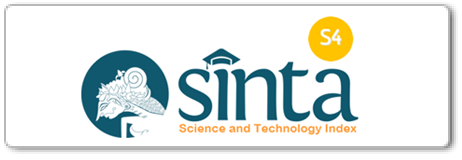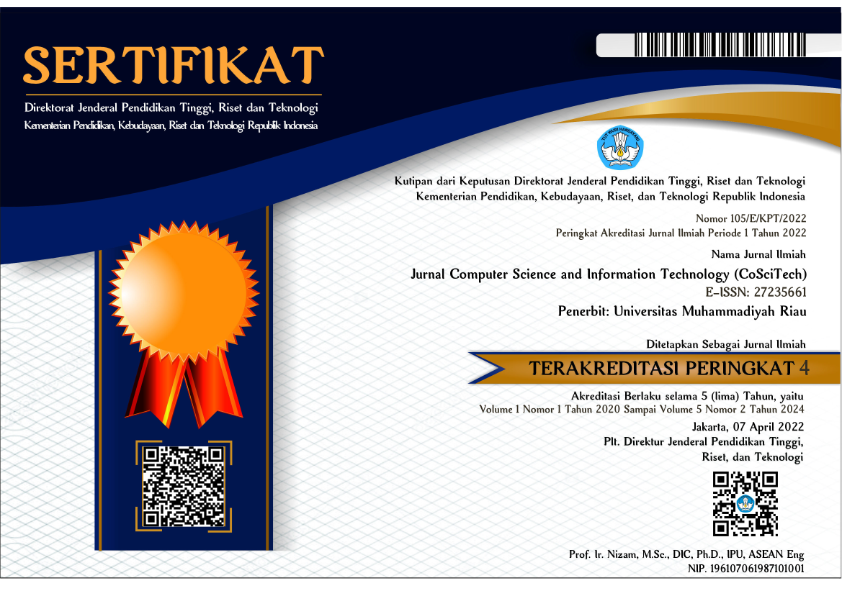Toddler Food Choice Decision Support System Using Android-Based Weighted Product Method
DOI:
 https://doi.org/10.37859/coscitech.v5i2.7240
https://doi.org/10.37859/coscitech.v5i2.7240
Abstract
Parents often find it challenging to choose the right foods that meet their toddlers' nutritional needs. Nutritional requirements are crucial during the growth and development phase of toddlers. Ensuring toddlers get proper nutrition is vital for their growth. Selecting the wrong foods can lead to insufficient nutrition, which could hinder their growth and development. This research aimed to develop an Android-based decision support system for selecting toddler foods and making it easier for parents to choose the right foods for their toddlers. This research employed the Weighted Product method, based on six criteria: carbohydrates, protein, fat, vitamin A, iron, and zinc. The data were collected by reviewing literature, conducting field studies, and using the System Development Life Cycle (SDLC) waterfall model for system development. The results rank forty different types of food, with fried shrimp being the top-ranked option. The accuracy of the Weighted Product method is calculated to be 100%.
Downloads
References
[2] Kementerian Kesehatan Republik Indonesia, “BUKU SAKU Hasil Survei Status Gizi Indonesia (SSGI) 2022,” 2022.
[3] Menteri Kesehatan Republik Indonesia, PERATURAN MENTERI KESEHATAN REPUBLIK INDONESIA NOMOR 41 TAHUN 2014. Kementrian Kesehatan Republik Indonesia, 2014.
[4] S. Anggraeni and S. F. Smanaob, “Faktor-Faktor yang mempengaruhi Pemenuhan Gizi pada Anak Usia Pra Sekolah,” 2022.
[5] Y. Wulandari, L. Apriyanti, M. Meiyansari, and Y. Febrieantha Putri, “PARENTING KESEHATAN DIRI DAN LINGKUNGAN: PENTINGNYA GIZI BAGI PERKEMBANGAN ANAK,” Jurnal Multidisipliner Bharasumba, vol. 1, no. 1, 2022.
[6] T. Julianawati, R. Husnah, S. Nuranisa, and H. D. Yanti, “Peningkatan Status Gizi Seimbang Bayi dan Balita terhadap Kejadian Stunting Bukit Raya,” Jurnal Pemberdayaan Masyarakat Berkarakter, vol. 5, no. 2, pp. 153–158, 2022, [Online]. Available: http://journal.rekarta.co.id/index.php/jpmb
[7] E. P. Silmina and T. Hardiani, “Sistem Pendukung Keputusan Pemilihan Menu Makan untuk Balita Menggunakan Metode Weight Product,” Jurnal INOVTEK Polbeng, vol. 7, no. 2, 2022.
[8] A. N. Afifah and A. Firdonsyah, “Design of Decision Support System for Food Selection for Diabetes Mellitus Type 2 Using Weighted Product Method (Case Study: Puskesmas Temon II Kulon Progo),” in Procedia of Engineering and Life Science, Sidoarjo: Universitas Muhammadiyah Sidoarjo, Jun. 2021.
[9] Ricki ardiansyah, Maha rani, and Rini sovia, “Penerapan Metode Weighted Product (WP) Dalam Menentukan Diagnosa Penyakit Mulut dan Gigi,” Jurnal CoSciTech (Computer Science and Information Technology), vol. 3, no. 3, pp. 382–388, 2022, doi: 10.37859/coscitech.v3i3.4283.
[10] E. G. Sihombing, C. Dyno, E. Arisawati, L. S. Dewi, and Rinawati, “IMPLEMENTASI WEIGHT PRODUCT (WP) UNTUK PEMILIHAN BUBUR BAYI INSTAN USIA 6 BULAN+,” Kumpulan jurnaL Ilmu Komputer (KLIK), vol. 7, no. 3, 2020.
[11] Rangga Gelar Guntara, “Aplikasi Pendeteksi Penyakit Telinga Berbasis Android menggunakan API Clarifai dan K-Nearest Neighbor,” Jurnal CoSciTech (Computer Science and Information Technology), vol. 3, no. 2, pp. 81–90, Aug. 2022, doi: 10.37859/coscitech.v3i2.3862.
[12] I. Sommerville, Software Engineering: Global Edition, Tenth Edition. 2016. [Online]. Available: http://iansommerville.com/software-engineering-book/
[13] B. Rumpe, Modeling with UML. Springer International Publishing, 2016. doi: 10.1007/978-3-319-33933-7.
[14] L. Setiyani, “PENGUJIAN SISTEM INFORMASI INVENTORY PADA PERUSAHAAN DISTRIBUTOR FARMASI MENGGUNAKAN METODE BLACK BOX TESTING,” Techno Xplore Jurnal Ilmu Komputer dan Teknologi Informasi , vol. 4, no. 1, Apr. 2019.
[15] S. R. Dana, E. P. Silmina, and S. L. Mufreni, “Sistem Pakar Diagnosis Risiko Kanker Payudara Menggunakan Forward Chaining Berbasis Android,” 2020.
[16] D. S. Kania, D. M. Afirahmi, D. P. Nuria, and D. Yusup, “Perancangan dan Pengembangan Aplikasi E(AT)VERYDAY sebagai Sistem Pemesanan Kantin Berbasis Website,” INNOVATIVE: Journal Of Social Science Research, vol. 3, no. 3, pp. 518–528, 20232.













